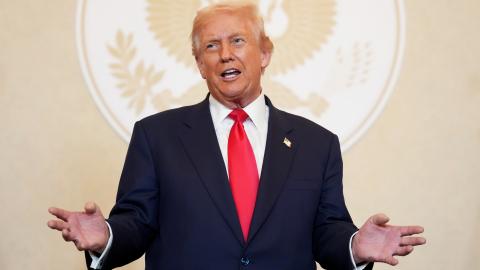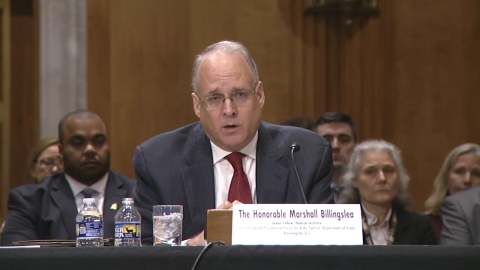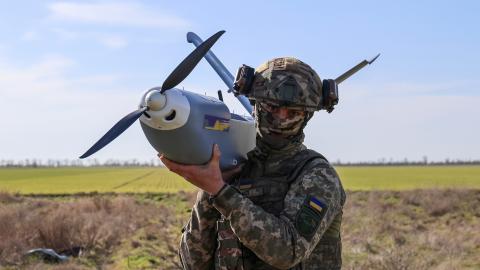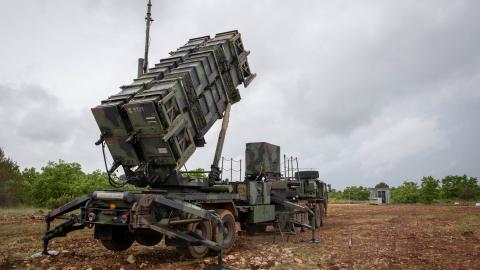Mention the Golden Dome within the Washington Beltway and you’ll immediately get dragged into a debate about whether space-based missile defenses can be cost-effective. The question is, compared to what? Currently, U.S. and allied strategic defense depends primarily on threatening massive nuclear missile retaliation against major acts of aggression. This raises a fundamental question: Does it make more sense to spend more on the Golden Dome or buying ever more offensive nuclear intercontinental ballistic missiles, like the Sentinel?
The Trump Administration’s Golden Dome initiative seems to set forth an impossible goal: defend the United States from all air and missile attacks. America has depended on its friendly neighbors and oceanfront location to do that for centuries, but drone, missile, and space technologies closed the distance. The United States cannot afford to ignore the threat, so the question becomes how to build a Golden Dome it can afford?
There are many choices, most of which proved themselves in the Middle East and Ukraine. Land-based defenses like Patriot and Terminal High Altitude Air Defenses (THAAD) are effective against cruise and ballistic missiles but only cover a couple hundred miles. Fighters can intercept missiles across larger regions. And ship or ground-based ballistic missile defenses like the SM-3 interceptor can take out small ballistic missile salvos at 1000-mile plus ranges. But none of these systems provides both continental reach and high capacity.
To achieve this requires space-based interceptors. Their development and deployment, though, won’t be cheap.
Currently, the Pentagon is spending hundreds of billions of dollars to modernize our land-based intercontinental ballistic missile force with the Sentinel system. This program is in trouble. In its fifteenth year, the program is now 81% over budget and its estimated first test flight has recently slipped by five years.
If we look at not just the Sentinel program, but the bomber and ballistic missile submarine programs, along with their required command, control, communications, and intelligence systems, the Congressional Budget Office estimates that, over the next decade, America will spend nearly a trillion dollars. If we factor in the fully burdened life cycle costs, which includes not just their development, construction, and maintenance, but related manning costs, the number further goes up.
Factoring in these expenses, would it make more sense to buy less nuclear offenses and more space-based missile defenses to reduce the probability of nuclear first strikes? Maybe.
The reasoning is counter intuitive. In the Middle East and Ukraine, offensive missiles and drones are cheap; defensive missile systems are expensive. Also, the consequences of a few leakers with conventional missiles are relatively tolerable. When it comes to intercontinental-range nuclear missiles, though, if the defenses aren’t robust and the leakage is heavy, the consequences are enormous. That could be the argument for investing in robust space-based missile defense systems.
Another way to think about how robust strategic defenses could reduce the need to build out a 400-missile Sentinel force is to consider how many fewer missiles one would need if missile defenses were able to protect most of them against a first strike. Instead of losing some, its conceivable space-based missile defenses in conjunction with ground-based defenses could protect the entire force against such a strike. In this case, could one get by, perhaps, with half as many Sentinel missiles?
Also, some security experts have proposed reducing the Sentinel’s vulnerability by making it road-mobile. The United States attempted such efforts before. They were too controversial and costly to implement. On the other hand, if missile defenses can reduce the Sentinel forces’ vulnerability sufficiently, might it be unnecessary to go mobile?
Another consideration is the increasing difficulty of limiting the damage a Chinese, Russian, or North Korean nuclear attacks might inflict against the United States or its allies. All three countries are growing their nuclear missile arsenals, diversifying their launch vehicles, hardening these systems’ command and controls, and increasing all of these systems’ mobility. Do we know how to neutralize these difficult target sets? If not, should America bank on its threat-to-counterstrike to deter a first strike and to limit damage after they’re fired?
Some military experts favor deploying more U.S. offensive nuclear forces overseas. Others disagree. If the Dome’s protection is robust enough and extended to our allies, does the United States need to forward deploy at all?
It would be worth getting the answers to these questions. These inquiries should not be confused with the red herring of determining if our missile defenses can be 100 percent leak-proof. They never will be. Instead, we need to determine, at various levels of effectiveness, what the cost-benefit ratio might be to reduce the probability of missile first strikes.
One thing is certain. Dwelling on what the Golden Dome system will cost without clarifying what its security benefits might be, is a formula for miscalculation.
Read the original co-authored with Henry Sokolski in RealClearDefense.















